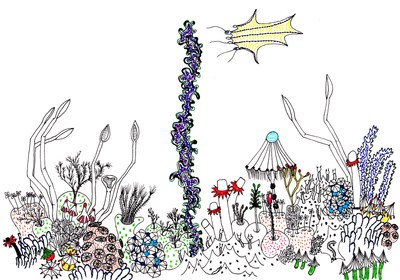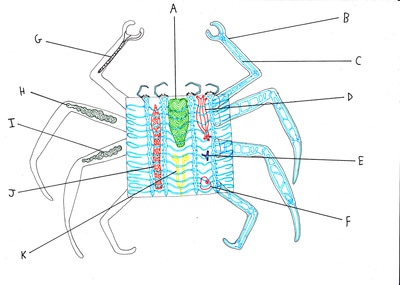|
Isla is the creation of DeviantArt user bionautic (also on Instragram and YouTube). It is a tidally-locked world where life lives only near the “twilight zone” between the cold night side and the hot day side. Plants are often flat to deal with the constant wind in this area, though some rise above the surface somewhat to better capture the very horizontal sunlight.
Though lower in biodiversity than Earth, there are several interesting bidirectional animals described, as well as some of the variety in spore dispersal used by the plants. Isla is also a world I can feel at home in while it captures the imagination. It has many cozy nooks and crannies created by the plants, whether it is the gaps between the generational reefs of flat desert plants, the root mesh underneath large plant colonies, or the world under the solid canopies of the “spore forests.” Although I have seen many equally-good artists, this is the best art I have seen that was coupled with clear biological prose into a real project.
0 Comments
One of the most imaginative projects I’ve seen in a long time, planet Polinices created by DeviantArt user doublejota is dedicated to the question of how far we can take the concept of a colonial organism. There are worms that bud smaller versions of themselves from within their stomachs, who in turn bud more. Some colonies remain wormlike while others branch and house symbiotic algae. Some colonies are circular and roll like tank treads while others are donutlike and lined with needlelike teeth on the inner surface.
Some colonies have three members that resemble a fish and two large pectoral fins. They can move by fins or by siphons. Some colonies have two main members that face opposite directions and resemble Earth fish except for the four eyes in the middle of the body (derived from the gastric sacs of smaller members). Some colonies grow a long tubular shell that curves back and forth and some of these resemble fish in overall appearance with the propulsion tail member surrounded in two dimensions by serpentine shell. In some colonies, the members detach and cooperate in ways reminiscent of a beehive. Forager drones gather food and bring it to the queen for digestion. Some swim. Some crawl. They communicate by radio and require repeater drones due to the limited range of radio waves in water. There are many variations on this theme, including the drones lining up as in a buffet, drones stringing together in chains while they filter-feed and are passed through the queen, and queens without drones that mimic radio calls to lure in the drones of others as prey. There are also members that fully detach and roam in packs. Only some can digest, some can capture prey, and some can reproduce. It’s an extreme form of caste system similar to something I thought up once. Furthermore, I also enjoy the variety within the variety. Some colonies have eyes on each end, but in some of those colonies the lenses of the eyes have overgrown into giant shells that the colony can pull together to cover itself. There are many kinds of shells and in some colonies the two shells can have different shapes and sizes. A lot of thought has gone into this project. I have barely scratched the surface in covering it and have left quite a lot unsaid. The art is great and includes a mixture of diagrams and landscapes. Many of the animals are multicolored with sharp contrasts like tropical reef fish on Earth. It sets up a feeling that’s enough to just immerse yourself in after a long day. Fortunately, there is talk of a future book. |
Like alien art? Check out my store.
Copyright © 2017



 RSS Feed
RSS Feed